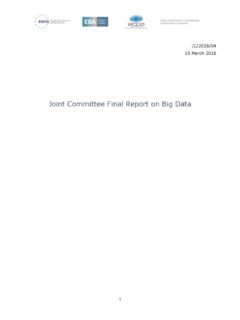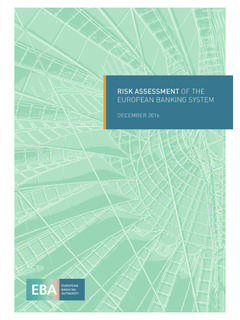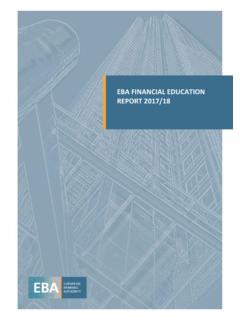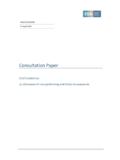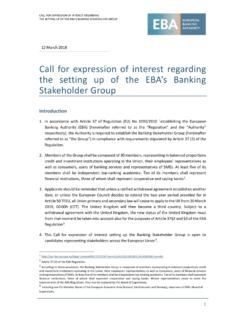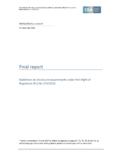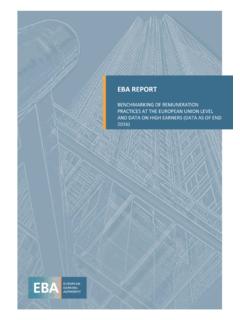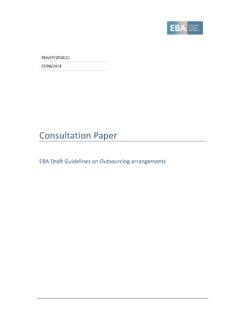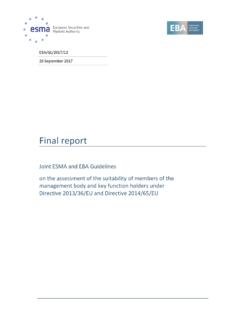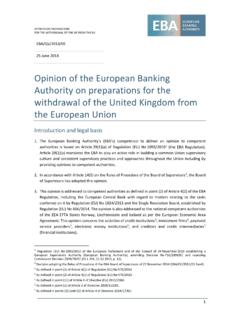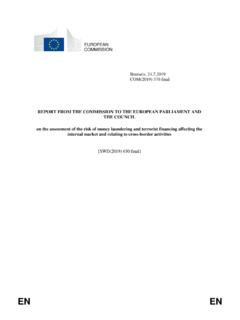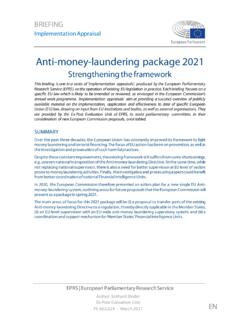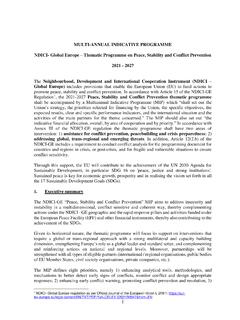Transcription of Final Report - European Banking Authority
1 EBA/GL/2021/02. 1 March 2021. Final Report Guidelines on customer due diligence and the factors credit and financial institutions should consider when assessing the money laundering and terrorist financing risk associated with individual business relationships and occasional transactions ( The ML/TF Risk Factors Guidelines') under Articles 17 and 18(4) of Directive (EU) 2015/849. Final Report ON GUIDELINES ON CUSTOMER DUE DILIGENCE AND THE FACTORS CREDIT AND. FINANCIAL INSTITUTIONS SHOULD CONSIDER WHEN ASSESSING THE ML/TF RISK ASSOCIATED WITH. INDIVIDUAL BUSINESS RELATIONSHIPS AND OCCASIONAL TRANSACTIONS. Contents 1. Executive summary 3. 2. Abbreviations 6. 3. Background and rationale 7. Background 7. Rationale 8. Guidelines 15. 4. Accompanying documents 138. Cost-benefit analysis/impact assessment 138. Overview of questions for consultation 146. Summary of responses to the consultation and the EBA's analysis 148.
2 2. Final Report ON GUIDELINES ON CUSTOMER DUE DILIGENCE AND THE FACTORS CREDIT AND. FINANCIAL INSTITUTIONS SHOULD CONSIDER WHEN ASSESSING THE ML/TF RISK ASSOCIATED WITH. INDIVIDUAL BUSINESS RELATIONSHIPS AND OCCASIONAL TRANSACTIONS. 1. Executive summary On 26 June 2015, Directive (EU) 2015/849 on the prevention of the use of the financial system for the purposes of money laundering or terrorist financing (ML/TF) entered into force. It recognised that the risk of ML/TF can vary and that Member States, competent authorities and obliged entities have to take steps to identify and assess that risk with a view to deciding how best to manage it. It also required the European Supervisory Authorities (ESAs) to issue guidelines on key aspects of the risk-based approach. In June 2017, the three ESAs issued Guidelines on risk factors and simplified and enhanced customer due diligence (JC 2017 37).
3 These guidelines set out factors firms should consider when assessing the ML/TF risk associated with a business relationship or occasional transaction. They also set out how firms can adjust the extent of their customer due diligence measures in a way that is commensurate to the ML/TF risks they have identified. Since then, the applicable legislative framework in the EU has changed, and new risks have emerged. On 9 July 2018, Directive (EU) 2018/843 entered into force. This directive amended Directive (EU) 2015/849 and introduced a number of changes that warranted a review of the Risk Factors Guidelines to ensure their ongoing accuracy and relevance; this was the case in particular in relation to the provisions on enhanced customer due diligence related to high-risk third countries. Furthermore, the ESAs' 2019 Joint Opinions on the ML/TF risk affecting the EU's financial sector highlighted ongoing concerns, by competent authorities across the EU, about firms' identification and assessment of both business-wide risk and the risk associated with individual business relationships, and the application of CDD measures.
4 To support firms' AML/CFT compliance efforts and enhance the ability of the EU's financial sector effectively to deter and detect ML/TF, these guidelines have been updated regarding: business-wide and individual ML/TF risk assessments;. customer due diligence measures including on the beneficial owner;. terrorist financing risk factors; and new guidance on emerging risks, such as the use of innovative solutions for CDD purposes. As was the case previously, these Guidelines are divided into two parts: Title I is generic and applies to all firms. It is designed to equip firms with the tools they need to make informed, risk-based decisions when identifying, assessing and managing ML/TF risk associated with individual business relationships or occasional transactions. 3. Final Report ON GUIDELINES ON CUSTOMER DUE DILIGENCE AND THE FACTORS CREDIT AND. FINANCIAL INSTITUTIONS SHOULD CONSIDER WHEN ASSESSING THE ML/TF RISK ASSOCIATED WITH.
5 INDIVIDUAL BUSINESS RELATIONSHIPS AND OCCASIONAL TRANSACTIONS. Title II is sector-specific and complements the generic guidelines in Title I. It sets out risk factors that are of particular importance in certain of those sectors and provides guidance on the risk- sensitive application of Customer Due Diligence measures by firms in those sectors. So as to foster greater convergence of supervisory expectations of the measures firms should take to tackle emerging risks, additional sectoral guidelines have been added to the original Risk Factors Guidelines on crowdfunding platforms, providers of currency exchange services, corporate finance, and payment initiation services providers (PISPs) and account information service providers (AISPs). Therefore, in total Title II now contains thirteen sectoral guidelines about very different key financial sectors such as for instance correspondents Banking , retail Banking , electronic money , money remittance, life insurance and investments firms.
6 Together, Title I and Title II promote the development of a common understanding, by firms and competent authorities across the EU, of what the risk-based approach to AML/CFT entails and how it should be applied. Importantly, neither these guidelines nor the Directive's risk-based approach require the wholesale exiting of entire categories of customers irrespective of the ML/TF risk associated with individual business relationships or occasional transactions. Since 1 January 2020, following changes to Regulation (EU) No 1093/2010 by Regulation (EU). 2019/2175, the EBA has been solely responsible for leading, coordinating and monitoring AML/CFT. efforts across the entire EU financial sector. In 2019, the European legislature consolidated the AML/CFT mandates of all three ESAs within the EBA. According to Articles 17 and 18(4) of Directive (EU) 2015/849 as amended by Directive (EU) 2019/2177, the EBA is mandated to issue the ML/TF.
7 Risk Factors Guidelines and it was the EBA only that publicly consulted on a version of these guidelines between 5 February 2020 and 6 July 2020. The EBA held a public hearing on 15 May 2020. The Consultation Pape (JC 2019 87) attracted 58 responses from a wide range of stakeholders across sectors covered by these Guidelines. The EBA published the responses on its website on 4 August 2020. The EBA has reviewed and assessed the responses it received and brought changes to the guidelines where appropriate and necessary. This Report also explains where the EBA: agreed with some of the proposals made by respondents and made changes to the draft Guidelines as a result, with regard to Account Information Service Providers and Payment Initiation Service Providers in Guideline 18;. saw the need to provide additional clarity on the interpretation of new or amended Guidelines, in some of the cases where respondent requested this; and considered it relevant for respondents to become aware of other work that the EBA is pursuing ( on financial inclusion and the Action plan on dividend arbitrage trading schemes ( Cum-Ex/Cum-Cum')) that may be more relevant to them in the context of their questions.
8 4. Final Report ON GUIDELINES ON CUSTOMER DUE DILIGENCE AND THE FACTORS CREDIT AND. FINANCIAL INSTITUTIONS SHOULD CONSIDER WHEN ASSESSING THE ML/TF RISK ASSOCIATED WITH. INDIVIDUAL BUSINESS RELATIONSHIPS AND OCCASIONAL TRANSACTIONS. Next steps The guidelines will be translated into the official EU languages and published on the EBA website. The deadline for competent authorities to Report whether they comply with the guidelines will be two months after the publication of the translations. The guidelines will apply three months after publication in all EU official languages. Upon the date of application, the original guidelines (JC/2017/37) will be repealed and replaced with the revised guidelines. 5. Final Report ON GUIDELINES ON CUSTOMER DUE DILIGENCE AND THE FACTORS CREDIT AND. FINANCIAL INSTITUTIONS SHOULD CONSIDER WHEN ASSESSING THE ML/TF RISK ASSOCIATED WITH. INDIVIDUAL BUSINESS RELATIONSHIPS AND OCCASIONAL TRANSACTIONS.
9 2. Abbreviations AISP Account Initiation Service Provider AML Anti- money laundering BCs Bills for collection CDD Customer due diligence CFT Countering the financing of terrorism CSP crowdfunding service provider EBA European Banking Authority EDD Enhanced customer due diligence ESAs European Supervisory Authorities FATF Financial Action Task Force FIU Financial Intelligence Unit FRSBs FATF-style Regional Bodies FSAP Financial Sector Assessment Programme GDPR General Data Protection Regulation ICC International Chamber of Commerce IMF International Monetary Fund LCs Letter of Credits NRA National Risk Assessment OECD Organisation for Economic Co-operation and Development PEP Politically Exposed Person PISP Payment Initiation Service Provider RMA Risk Management Application SDD Simplified customer due diligence SNRA Supra National Risk Assessment SSPE Securitisation Special Purpose Entity 6.
10 Final Report ON GUIDELINES ON CUSTOMER DUE DILIGENCE AND THE FACTORS CREDIT AND. FINANCIAL INSTITUTIONS SHOULD CONSIDER WHEN ASSESSING THE ML/TF RISK ASSOCIATED WITH. INDIVIDUAL BUSINESS RELATIONSHIPS AND OCCASIONAL TRANSACTIONS. 3. Background and rationale Background 1. On 26 June 2015, Directive (EU) 2015/849 on the prevention of the use of the financial system for the purposes of money laundering or terrorist financing entered into force. In line with the FATF's standards, Directive (EU) 2015/849 put the risk-based approach at the centre of European Union's AML/CFT regime. It recognised that the risk of ML/TF can vary and that Member States, competent authorities and obliged entities have to take steps to identify and assess that risk with a view to deciding how best to manage it. 2. Article 17 and 18(4) of Directive (EU) 2015/849 required the European Supervisory Authorities to issue guidelines to support firms with this task and to assist competent authorities when assessing the adequacy of firms' application of simplified and enhanced customer due diligence measures1.
